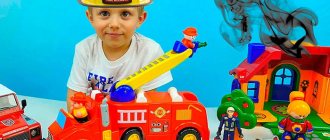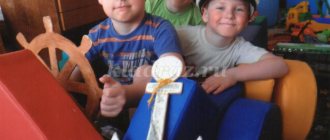Didactic game “What a firefighter needs”
The game, intended for middle school preschoolers, expands their understanding of the work of a firefighter. The lesson requires an image of a firefighter, as well as pictures depicting the attributes and tools that this worker cannot do without: a helmet, a fire truck, a fire extinguisher, a box of sand, etc. You also need to make several pictures with objects not related to firefighting.
The player looks at pictures of objects and selects those that the fireman uses. He must explain in detail the purpose of each tool.
Didactic games with children card index (senior group) on the topic
Didactic games with children on the topic: “Hospital.”
1. Didactic game “Name the objects”
Goal: to consolidate knowledge about the subjects necessary for the work of a doctor. Enter words from medical terminology into the active dictionary.
Guys, look at these objects and tell me what they are called. (Thermometer, syringe, cotton wool, bandage, phonendoscope, tablets, heating pad, brilliant green, tweezers, massager). Do you know what profession a person needs these items? To the doctor. What does a doctor do? He treats, monitors our health, gives vaccinations, massages, weighs, etc.)
2. Didactic game “Tell me what these objects do”
Goal: to activate verbs and the use of nouns with them in children’s speech.
Tell me, how does the doctor use these items? What does a doctor do with a syringe? Gives injections. What does a doctor do with a thermometer? Measures temperature. What does a doctor do with cotton wool? Lubricates the skin before injection. What does a doctor do with brilliant green? Lubricates the scratch. What does a doctor do with a bandage? Bandages the wound. What does a doctor do as a massager? Gives a massage. What does a doctor do with a phonendoscope? Listens to breathing and heartbeat. What does a doctor do with a heating pad? Warms up the sore spot. What does a doctor do with tweezers? He takes out the splinters. What does a doctor do with a band-aid? Seals calluses.
3. Didactic game “Find the differences”
Goal: to develop voluntary attention, observation, to consolidate the ability to distinguish and name colors.
Take a look at this picture. Who is depicted on it? Doctor. Why do you think doctors wear white coats? If the robe gets dirty, it will be immediately noticeable on the white, and the robe will be washed. Who is in this picture? Also a doctor. Are these pictures the same? These pictures are very similar, but still not the same. Your task is to find the differences.
4. Didactic game “Which doctor should we go to?”
Goal: to train children in distinguishing facial expressions and comparing them with feelings and emotions. Learn to speak in complex sentences.
Guys, look at these faces. Which of these doctors would you go to? Why? (Kind, affectionate, cheerful, attentive, caring). How do you greet and introduce yourself to the doctor? Hello, my name is ..., and what worries me is ...
5. Didactic game “Vitamins are pills that grow on a branch”
Goal: expand children's knowledge about vitamins, consolidate knowledge about vegetables, fruits and berries.
Guys, you can help maintain health and get sick with the help of vitamins. Have any of you taken vitamins? Vitamins make our body strong and healthy, resistant to disease. But vitamins come not only in tablets, they also grow on branches. A lot of vitamins are found in berries, fruits and vegetables. Name what fruits do you know? Vegetables? Berries?
6. Didactic game “Who will be the first to help.”
Goal: teach children to use first aid techniques, develop reaction speed.
Two children are selected. The patient can be a doll. The teacher shows that the doll has a pain, for example, the children need to bandage the doll’s leg on command. Whoever is first wins.
7. Didactic game “Who hurts?”
Goal: to guess the state of a person by movement, by emotion.
One child is selected. The teacher gives all the other children a task (eg: show that your leg hurts, show that you have a headache, etc.). The child who was chosen guesses who has what hurts.
8. Didactic game “Who treats what.”
Goal: to consolidate children’s knowledge of doctors’ specializations.
The teacher shows pictures of doctors. Children must determine which doctor specializes in what, that is, what he treats.
9. Didactic game “Game of riddles.”
Goal: to develop memory, attention, speed of thinking. The teacher asks riddles, the children answer.
10. Didactic game “What does a doctor need?”
Goal: to consolidate children's knowledge about medical instruments.
The teacher names different objects, the children listen carefully, and when an object is called that the doctor needs in his work, they clap. (Robe, syringe, umbrella, bandage, iodine, thermometer, toy, notepad, pen, plate, hairpin, scarf, medicine, glass and so on.)
Play doctor
Nothing human is alien to medical workers, including the passion for computer games. 80% of American medical school students even believe that games “about doctors” have educational value. They are echoed by Russian specialists - last year they borrowed the SCA Life simulation program from their European colleagues, which helps to practice first aid skills for cardiac diseases.
Of course, people who, for one reason or another, did not go to study to become doctors, do not need specialized training programs. But the romance of white coats and selfless struggle for the life of a patient is so popular among ordinary people that serious corporations specializing in virtual entertainment for adults are developing computer games that are in one way or another related to medicine.
Didactic game “Who needs what for work”
The game introduces preschoolers to specialists in various professions: policeman, builder, fireman, doctor, school teacher, salesman, cook, kindergarten teacher, artist, traffic controller.
For the lesson, you need to prepare large A5 size cards depicting representatives of the above professions. You also need to make smaller pictures, approximately 10x10 cm, depicting the objects and tools used by the represented specialists. The number of pictures is arbitrary.
You can play in several ways:
- Game for one player or a subgroup of 1-3 people. The presenter shows a card with a picture of the employee. Players select pictures with the tools that this specialist uses and give reasons for each of their choices. In a subgroup lesson, the player who makes the fewest mistakes wins.
- Game for a group. The presenter distributes cards with representatives of professions to the players. Then he shows pictures of objects one by one. The child, having guessed that this instrument is suitable for his specialist, picks up his card and explains the choice in detail.
- Individual game. The player takes any card he likes depicting an employee and talks in detail about the profession. Next, he selects pictures of the tools that the described specialist uses.






